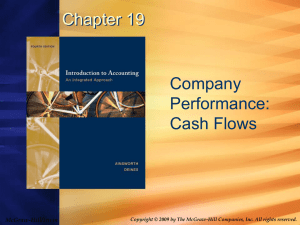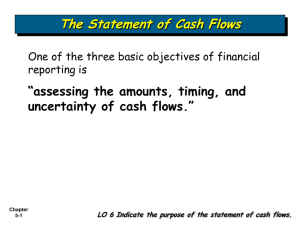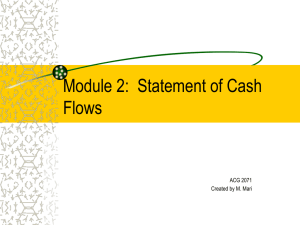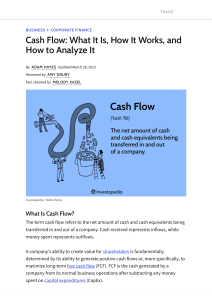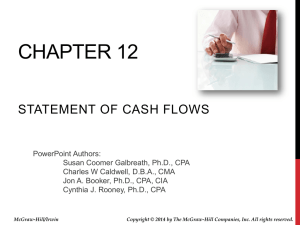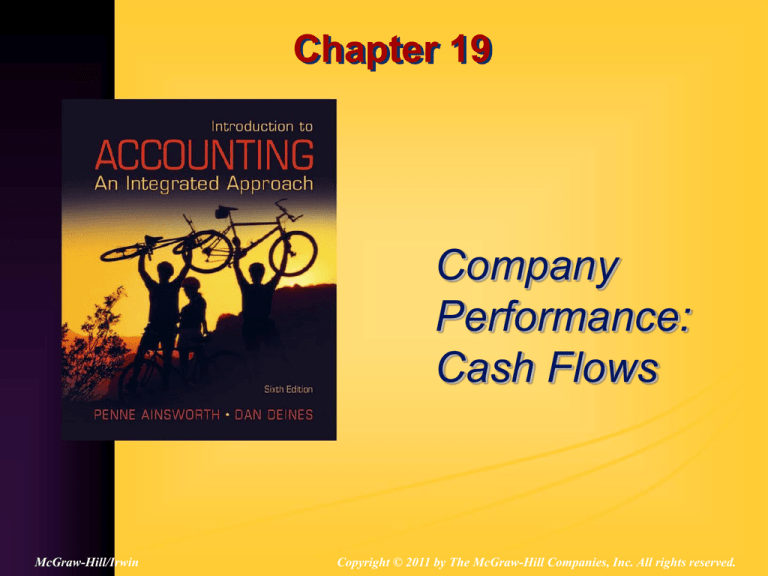
Chapter 19
Company
Performance:
Cash Flows
McGraw-Hill/Irwin
Copyright © 2011 by The McGraw-Hill Companies, Inc. All rights reserved.
Why Do We Need a Statement of
Cash Flows?
• Assess ability to generate future cash
• Assess ability to meet obligations and pay
dividends
• Understand the difference between net
income and cash flows
• Understand cash and noncash investing and
financing activities
19-2
What are the Sections of the
Statement of Cash Flows?
• Operating activities
Relating revenues and expenses to current,
operating assets and current, operating
liabilities
• Investing activities
Buying and selling long-term and other
investment assets
• Financing activities
Issuing and retiring long-term and other
financing liabilities and owners’ equity
19-3
How Do We Determine Operating
Cash Flows—Direct?
• Revenues versus cash inflows
Analyze current, operating assets and current,
operating liabilities related to revenues to determine
cash inflows
• Expenses versus cash outflows
Analyze current, operating assets and current,
operating liabilities related to expenses to determine
cash outflows
• Revenues and cash inflows
If a revenue does not have a related balance sheet
account, we assume the revenue was received in
cash
• Expenses and cash outflows
19-4
If an expense (excluding noncash expenses) does
not have a related balance sheet account, we
assume the expense was paid in cash
How Do We Determine Operating
Cash Flows—Indirect?
• Adjust net income for noncash expenses
Add back depreciation, amortization, and
depletion expense
• Adjust net income for nonoperating items
Add back losses
Subtract out gains
• Adjust net income for changes in current,
operating accounts
19-5
How Do We Adjust Net Income for
Changes in Current, Operating Accounts?
• Changes in current, operating assets
If the asset increases, subtract the change
If the asset decreases, add the change
• Changes in current, operating liabilities
If the liability increases, add the change
If the liability decreases, subtract the change
19-6
How Do We Determine Cash Flows
from Investing Activities?
• Analyze long-term assets for purchases and
sales
• Analyze current, nonoperating assets for
purchases and sales
• Analyze the income statement for gains and
losses to determine cash flows from sales
19-7
How Do We Determine Cash Flows
from Financing Activities?
• Analyze long-term liabilities for issuances
and retirements of debt
• Analyze owners’ equity accounts for
issuances and retirements of stock
• Analyze retained earnings for dividend
declarations
• Analyze current, nonoperating liabilities for
issuances of debt or declarations of
dividends and retirements of debt or
payment of dividends
19-8
What Other Items are Disclosed on
the Statement of Cash Flows?
• Investing and financing activities not
requiring cash
Significant
Future cash flow implications
19-9
How Do We Evaluate Cash Flows
Internally?
• Cash flow per share
• Comparison to past
• Comparison to competitors
19-10

